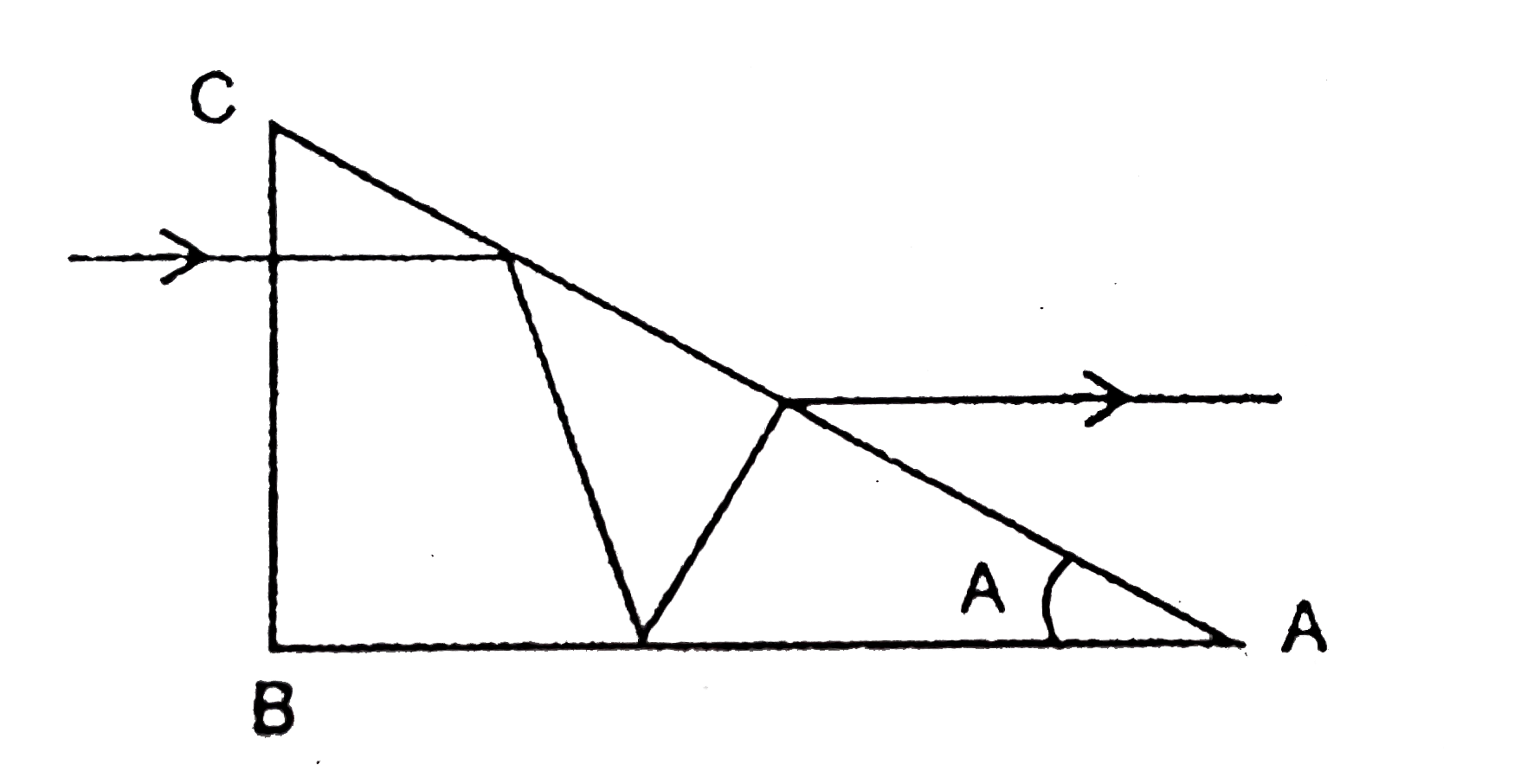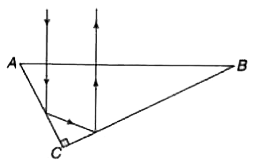A right angled prism is to be made by selecting a proper material and the angles A and B (B≤A),asshown∈figure.Itisdesiredtˆarayoflight∈cntonthefaceABemer≥sparal≤l→the∈cntdirectionaftertwo∫ernalref≤ctions.<br><imga≤ocr_imageload∈g=lazysrc=https://d10lpgp6xz60nq.cloudfront.net/physics_images/DCP_V05_C31_S01_034_Q01.pngwh=80%mx-autosty≤=background:white;><br>(a)Wˆshod––betheminiμmretive∈dexnforthis→bepossib≤?<br>(b)Forn=5/3isitpossib≤→aχevethiswiththe∠Bequal→30 degrees?Solution in Gujrati

a. Consider the ray incident normally oN/AB ure. The asngle of reflectin at the surface AC is theta. It is clear from the ure that the angle of incidence ast th secon surface CB is 90∘−θ. The emergent ray will be paralel to the incidnet ray after two total inteN/Al refelection.The critical angle θc should be less than theta as well as 90∘−θ. Thus θc should be smaller than or equal to the smaler of θand90∘−θ,i.e,
theta_clemin(theta,90^@-theta)<br>Asmin(θ,90∘−θ)≤45∘,θc≤5∘
or sinθc≤1√2or1μ≤1√2
or μ≥1√2
Thus the refrctive index of the material of hte prism should be greater than or equal to √2. In this case teh gien ray can undrgo tow inteN/Al reflections for a suitable theta.
b. For μ=53 the critical angle θc is
sin−1(35)=37∘
As the ure suggests we consider the lightincident normally on the face AB. The angle of incidence θ on the surface AC is equal to θ=60∘. As this is larger than the cirtical angle 37∘, total internla reflection takes place here. The angle of incident at the surface CB is 90∘−θ=30∘. As this is less than teh critial ange, total interN/Al reflection does not take place at this surface.
Topper's Solved these Questions
- BOOK - HC VERMACHAPTER - GEOMETRICAL OPTICSEXERCISE - Short Answer18videos
GEOMETRICAL OPTICS
- BOOK - HC VERMACHAPTER - GEOMETRICAL OPTICSEXERCISE - Question For short Answer1videos
GEOMETRICAL OPTICS
- BOOK - HC VERMACHAPTER - GEOMETRICAL OPTICSEXERCISE - EXAMPLE3videos
GEOMETRICAL OPTICS
- BOOK - HC VERMACHAPTER - GAUSS LAWEXERCISE - Exercises24videos
GAUSS LAW
- BOOK - HC VERMACHAPTER - LIGHT WAVESEXERCISE - Exercises41videos
LIGHT WAVES
Similar Questions
Is the formula "Real depth/Apparent depth =μ. valid if viewed from a position quite away from the normal ?
07:01View SolutionTwo converging lenses of unequal focal lengths can be used to reduce the aperture of a parallel beam of light without loosing the energy of the light. This increases the intensity. Describe how the converging lenses should be placed to do this.
07:01View SolutionA convex mirror has its radius of curvature k=20 cm. Find the position of the image of an object placed at a distance of 12 cm from the mirror.
 02:39View Solution
02:39View SolutionThe electric field in a region is given by →E=35E0→i+45E0→j with E0=2.0×103NC−1. Find the flux of this field through a recatngular surface of area 0.2m2 parallel to the y-z plane.
06:32View SolutionFind the range of frequency of light that is visible to an average human being (400nm<λ<700nm)
02:32View SolutionA right angled prism is to be made by selecting a proper material and the angles A and B (B≤A),asshown∈figure.Itisdesiredtˆarayoflight∈cntonthefaceABemer≥sparal≤l→the∈cntdirectionaftertwo∫ernalref≤ctions.<br><imga≤ocr_imageload∈g=lazysrc=https://d10lpgp6xz60nq.cloudfront.net/physics_images/DCP_V05_C31_S01_034_Q01.pngwh=80%mx-autosty≤=background:white;><br>(a)Wˆshod––betheminiμmretive∈dexnforthis→bepossib≤?<br>(b)Forn=5/3isitpossib≤→aχevethiswiththe∠Bequal→30 degrees?
02:59View SolutionA right angled prism is to be made by selecting a proper material and the angles A and B (B≤A),asshown∈figure.Itisdesiredtˆarayoflight∈cntonthefaceABemer≥sparal≤l→the∈cntdirectionaftertwo∫ernalref≤ctions.<br><imga≤ocr_imageload∈g=lazysrc=https://d10lpgp6xz60nq.cloudfront.net/physics_images/DCP_V05_C31_S01_034_Q01.pngwh=80%mx-autosty≤=background:white;><br>(a)Wˆshod––betheminiμmretive∈dexnforthis→bepossib≤?<br>(b)Forn=5/3isitpossib≤→aχevethiswiththe∠Bequal→30 degrees?
06:30View SolutionA ray of light incident at an angle θ on a refracting face of a prism emerges from the other face normally. If the angle of the prism is 5∘ and the prism is made of a material of refractive index 1.5, the angle of incidence is.
03:08View SolutionA ray of light incident normally on one of the faces of a right-angle isosceles prism is found to be totally reflected as shown in the figure. What is the minimum value of the refractive index of the material of the prism? When the prism is immersed in water, trace the path of the emergent ray for the same incident ray, indicating the values of all the angles (mu_omega=4//3) .
View SolutionA ray of light falls normally on one face of a right angled prims of refracting angle A. It suffers two total internal reflections before coming out of prism parallel to incident ray as shown. Refractive index to prism material will be:
 04:11View Solution
04:11View Solutionचित्र में ABC एक समकोणिक प्रिज्म है जिसमें ∠C=90∘ तथा ∠A>∠B

एक प्रकाश किरण, फलक AB पर अभिलंबवत आपतित होती है तथा दो पूर्ण आंतरिक परावर्तन के पश्चात् फलक AB के लंबवत ही बाहर निकल जाती है।
यदि ∠B=30∘ हो तो क्या यह संभव है कि प्रिज्म के पदार्थ का अपवर्तनांक 53 होगा ?05:52View Solutionएक समकोण प्रिज्म ऐसे पदार्थ तथा कोणों A व (B≤A), का बनाना है कि ab पृष्ठ पर आपतित किरण दो आतंरिक परावर्तनों के पश्चात आपतन के ही समान्तर दिशा में निर्गत हो |
(a) इसके लिए न्यूनतम अपवर्तनांक n क्या होना चाहिए ?
(b) n=53 के लिए क्या यह संभव है, जबकि B का मान 30∘ हो ?
 05:17View Solution
05:17View SolutionA light ray is incident on one refraction face of a prism, of refractive angle A, at an angle of incidence, I and emerges from the opposite face, normally. If refractive index of the material of the prism be μ what will be the value of the angle of incidence?
06:03View SolutionA ray of light incident at an angle theta on a refracting face of a prism emerges from the other face normally. If the angle of prism is 5^(@) and the prism is made of a material of refractive index 1.5, the angle of incidence is
03:22View SolutionA ray of light incident at an angle θ on a refracting face of a prism emerges from the other face normally. If the angle of the prism is 5∘ and the prism is made of a material of refractive index 1.5, the angle of incidence is.
05:00View SolutionA ray of light incident at an angle θ on a refracting face of a prism emerges from the other face normally. If the angle of the prism is 5∘ and the prism is made of a material of refractive index 1.5, the angle of incidence is
03:10View Solution

